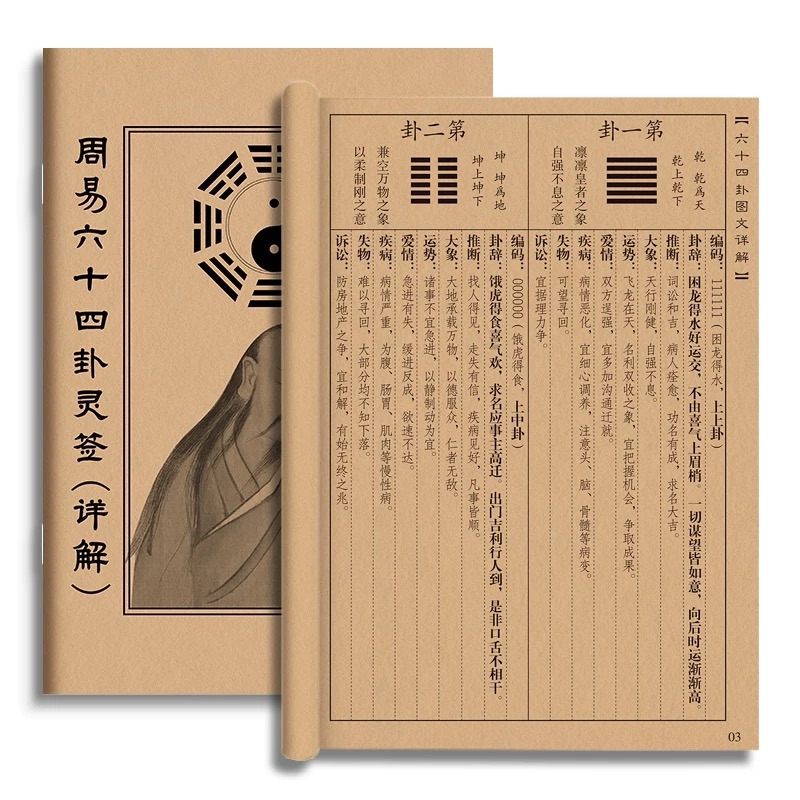Introduction
In traditional Chinese philosophy, the I Ching (Book of Changes), the Five Elements, the Eight Trigrams, the Four Pillars of Destiny, and the Heavenly Stems & Earthly Branches together form a comprehensive cosmology and metaphysical system. These concepts are interrelated yet distinct, and they are widely applied in divination, Feng Shui, traditional medicine, astrology, and philosophy.
- I Ching: The Fundamental Law of the Universe
The I Ching (Book of Changes) is one of the oldest and most profound Chinese philosophical classics, often referred to as the “first among all classics.” It establishes core principles such as cosmic change, yin-yang balance, and the interaction of the Five Elements.
📖 Core Concepts:
Yin-Yang Duality: Everything in the universe consists of yin and yang, two opposing yet interdependent forces, such as day (yang) and night (yin), rigidity (yang) and flexibility (yin).
Change and Balance: All things are in a state of continuous transformation, following natural cycles like spring growth, summer flourishing, autumn harvesting, and winter storing.
Eight Trigrams & Sixty-Four Hexagrams: These symbols are used to analyze situations, predict trends, and guide decision-making in divination, Feng Shui, and strategy.
🌟 Relationship:
The I Ching serves as the foundational theory for the entire system of the Five Elements, Eight Trigrams, Four Pillars of Destiny, and the Heavenly Stems & Earthly Branches, providing fundamental laws for cosmic operation.
- Five Elements Theory: The Fundamental Composition of All Things
The Five Elements (Wood, Fire, Earth, Metal, and Water) are an ancient Chinese framework used to explain natural phenomena, human health, and cosmic interactions. It suggests that everything in the universe is a result of the dynamic interplay of these five basic elements.
🌿 Five Elements and Their Correspondences:
Element Characteristics Direction Color Corresponding Organs
Wood 🌳 Growth, flexibility, expansion East Green Liver, Gallbladder
Fire 🔥 Heat, movement, transformation South Red Heart, Small Intestine
Earth 🌍 Stability, nourishment, grounding Center Yellow Spleen, Stomach
Metal ⚔️ Strength, structure, contraction West White Lungs, Large Intestine
Water 💧 Fluidity, cooling, adaptability North Black Kidneys, Bladder
🌀 Five Elements Interactions:
✔ Generating Cycle (Promoting Growth):
Wood nurtures Fire → Fire creates Earth → Earth produces Metal → Metal generates Water → Water feeds Wood.
❌ Controlling Cycle (Restraining Balance):
Wood overcomes Earth → Earth blocks Water → Water extinguishes Fire → Fire melts Metal → Metal cuts Wood.
🌟 Relationship:
The Five Elements theory is crucial in analyzing the relationship between humans and nature. In Four Pillars of Destiny (Ba Zi) astrology, a person’s Five Element balance determines personality, health, and fate.
- Eight Trigrams: The Symbolic System of Universal Phenomena
The Eight Trigrams (Ba Gua) are the core of the I Ching, consisting of Qian (☰), Kun (☷), Zhen (☳), Xun (☴), Kan (☵), Li (☲), Gen (☶), and Dui (☱). Each represents different natural elements and life aspects.
🌀 Eight Trigrams, Five Elements, and Directions:
Trigram Symbolism Element Direction
Qian ☰ Heaven Metal Northwest
Kun ☷ Earth Earth Southwest
Zhen ☳ Thunder Wood East
Xun ☴ Wind Wood Southeast
Kan ☵ Water Water North
Li ☲ Fire Fire South
Gen ☶ Mountain Earth Northeast
Dui ☱ Lake Metal West
🌟 Relationship:
The Eight Trigrams are a practical application of the Five Elements, playing a central role in I Ching divination, Feng Shui, and astrology. They are used to analyze environments and guide personal fate.
- Four Pillars of Destiny (Ba Zi): The Core of Personal Astrology
The Four Pillars of Destiny (Ba Zi) is a system that uses a person’s birth year, month, day, and hour to determine their character, fortune, and elemental balance.
📌 The Four Pillars:
Year Pillar (Ancestry, heritage)
Month Pillar (Parents, career)
Day Pillar (Self, marriage)
Hour Pillar (Children, late life)
📌 Eight Characters (Ba Zi):
Each pillar consists of a Heavenly Stem and an Earthly Branch, forming a total of eight characters (hence the name “Ba Zi”).
🌟 Relationship:
Ba Zi is a personalized application of the Five Elements theory, helping determine an individual’s innate strengths, weaknesses, and destiny path.
- Heavenly Stems & Earthly Branches: The Time & Energy System
The Heavenly Stems and Earthly Branches were developed as an ancient calendar system to mark time and energy cycles.
📌 Heavenly Stems (10):
Wood: Jia (甲), Yi (乙)
Fire: Bing (丙), Ding (丁)
Earth: Wu (戊), Ji (己)
Metal: Geng (庚), Xin (辛)
Water: Ren (壬), Gui (癸)
📌 Earthly Branches (12, linked to the Chinese Zodiac):
Rat (子), Ox (丑), Tiger (寅), Rabbit (卯), Dragon (辰), Snake (巳), Horse (午), Goat (未), Monkey (申), Rooster (酉), Dog (戌), Pig (亥)
🌟 Relationship:
The Heavenly Stems and Earthly Branches form the basis of Ba Zi astrology, calculating one’s fate based on cosmic influences.
Summary: The Interconnected System
📌 I Ching provides the fundamental philosophical principles governing the universe.
📌 Five Elements explain the composition and interactions of all things in nature.
📌 Eight Trigrams apply Five Elements principles to divination, Feng Shui, and astrology.
📌 Four Pillars of Destiny (Ba Zi) determines an individual’s character, health, and destiny.
📌 Heavenly Stems & Earthly Branches form the astrological calendar system that interacts with all the above.
Together, these concepts create a comprehensive framework for understanding human destiny, nature, and the universe, influencing Feng Shui, medicine, astrology, and philosophy.



Leave a Reply